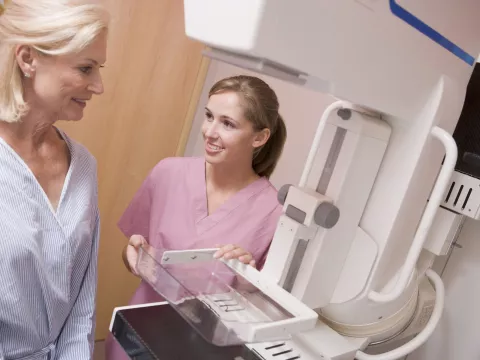- AdventHealth

We know that there are more pleasant things to do than getting your annual mammogram, but did you know that this 30-minute screening could mean the difference between catching cancer in its early stages, when its the most treatable, and a more challenging battle down the road?
The mammogram is our best way to detect breast cancer, and decades of research shows that women who have regular mammograms are more likely to have breast cancer detected early, which reduces the need for more aggressive treatments like surgery and chemotherapy, and offers a greater probability of being cured, says Olga Ivanov, MD, an AdventHealth breast surgeon.
Even knowing this, many women still decide against receiving this potentially life-saving screening. And many misconceptions about mammograms seem to be culprit. We want to protect your health and help you live your best life, which is why were debunking the top 6 mammogram myths. It's our hope that every woman feels inspired to get their annual mammogram without any of these myths getting in the way.
1. A mammogram takes too long; I have no time.
Fact: Exams usually take less time with digital mammography, and you are typically in and out of a screening mammogram in less than 30 minutes. Some locations offer weekend and after-hours appointments, and most can schedule a same or next-day appointment for your convenience.
2. Mammograms cost too much.
Fact: Many insurance companies cover 100 percent of the cost of a screening mammogram if you meet the criteria. Low-cost or fully-funded mammograms are also offered through national programs, community organizations and the AdventHealth Foundation.
3. Mammograms are painful.
Fact: Mammograms may be uncomfortable but should not be painful. With the transition to digital mammography, the level of discomfort you experience should be much less due to the new design of the compression paddles. The paddles flex with your body, applying pressure only where needed. In addition, digital exams are quicker and the compression time is less.
Avoid scheduling your mammogram the week leading up to the start of your menstrual cycle when your breasts tend to be more sensitive. Also, if you had a good mammogram experience, learn the name of your technologist and request her for your next mammogram appointment. We are happy to customize your experience to increase your comfort, says Ivanov.
4. I am afraid of finding something.
Fact: Eight out of ten breast lumps are not cancerous. However, see a physician immediately if you discover a lump or change in your breasts. Computer-aided detection (CAD) helps our specially-trained radiologists to be certain of their findings, make recommendations for further studies, and talk with referring physicians.
If you do receive a call about your mammogram, know that this happens to many women and often just means that further testing should be done to examine a possible area of concern. In fact, most mammogram findings end up being benign. says Dr. Ivanov.
She continues, If breast cancer is detected, finding it early can lead to more seamless and effective treatment, and our breast care clinicians will provide you with a continual source of support throughout the entire process.
5. The radiation from a mammogram can cause cancer.
Fact: Mammograms are very safe. Digital mammography uses the lowest radiation dose required to produce clear and precise exam images.
This is one of the most common concerns that I hear from patients; however, the amount of radiation from one mammogram per year is the same as you would get from getting on plane in Orlando and landing in Los Angeles, Ivanov states.
6. Mammograms are for older women only.
Fact: The American Cancer Society recommends that women age 40 and older should get a yearly screening mammogram for as long as a woman is in good health. However, if you have a family history of cancer, any new breast problem or other high-risk factors, it may be recommended to start screening at an earlier age.
The recommendations change depending on the authority that puts out mammogram screening guidelines, so it's important to discuss your personal screening schedule with your doctor, Ivanov recommends.
She adds, If you have a more complicated family or medical history, you might want to also speak to a breast surgeon or visit our breast center. Our specialists can help address your breast health concerns, assess your risk, run genetic tests and work together to map out a personalized screening or prevention plan for you.
So, now you're ready to make your mammogram appointment. Wed like to bring you more peace of mind by offering a few more tips to make your mammogram as comfortable as possible.
- Schedule your mammogram 10 to 14 days after the start of your menstrual cycle; the breasts are usually less tender.
- Avoid caffeine a week before your mammogram; it can make the breasts tender.
- If you experience pain, inform the technologist some simple repositioning may help.
Our breast health experts are here to support your journey to whole health. Schedule your potentially life-saving mammogram today.





